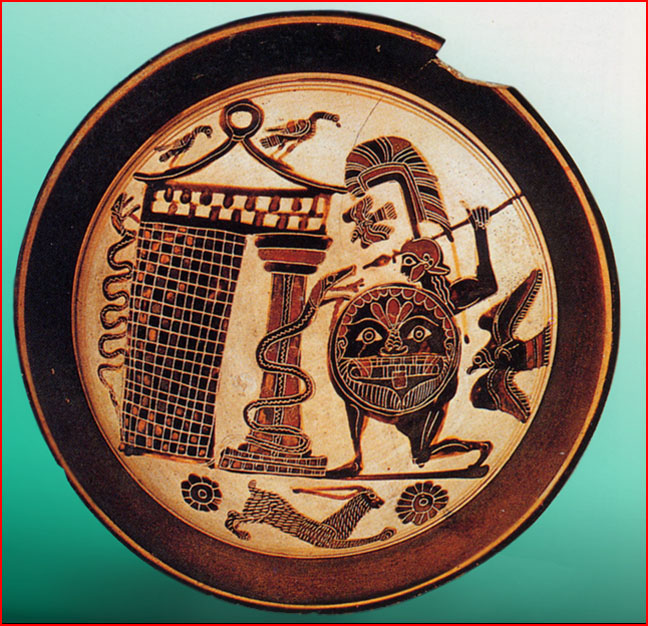|
Ancient stories of
cosmic battles, pitting a celestial warrior against a
serpent, dragon, or other monster, were integral to the
birth of civilization. From one early culture to
another, sacred monuments and rites, religious texts,
and cosmic symbols harked back to the age of the gods,
to earthshaking upheaval, and celestial combat.
One fact is
frequently overlooked, however. The context and setting
of the later stories progressively changed as the gods
were brought down to earth. Over time, the poets and
historians placed the stories on a landscape familiar to
them. In the course of Egyptian history, for example,
the creator Ra and his regent Horus, whose original
domain was undeniably celestial, came to be remembered
as terrestrial kings. In later time, when Greek and
Roman poets, philosophers, and naturalists sought to
gather knowledge from far flung cultures, Egyptian
priests would relate to them many stories of the gods,
declaring that the events had occurred in their own city
in the time of the ancestors.
By following this
evolutionary tendency across the centuries, the
researcher can observe how the cosmic thunderbolt, a
centerpiece in innumerable tales of celestial combat,
emerged as the magical weapon of a legendary hero. It
became the sword, spear, hammer or club of a warrior who
continued to battle chaos monsters, but no longer in the
heavens. As a result of localization, the diminished
hero typically reveals an enigmatic mix of god and man,
as in the well known accounts of the Sumerian and
Babylonian hero Gilgamesh. Once reduced to human
dimensions, the hero could no longer hold onto his
original weapon, a weapon claimed to have shaken and
forever changed both heaven and earth.
Localization of
the celestial dramas recorded in earliest times had a
huge impact on Greek imagination. The best indication of
the evolutionary process is Greek epic literature,
including the most popular tale of all, Homer's Iliad.
Here the greatest of Greek heroes, the ideal warrior, is
Achilles. The hero's tale provided the fulcrum upon
which the poet integrated different tribal memories,
bringing together dozens of tribal heroes upon the
battlefields of a legendary, and entirely mythological
Trojan War. But the original themes, though subdued, are
still present.
In the
illustration above, from a Greek drinking vessel, we
observe Achilles confronting the serpent-guardian of a
Trojan fountain. What is the relationship of this image
to the archaic contests between warrior gods and chaos
serpents?
Achilles' father
was the mythic king Peleus and his mother the "sea"
goddess Thetis, daughter of Oceanus, for whose
affections both Zeus and Poseidon had contended. Bathed
by his mother in the river Styx, the river that "joins
the earth and Hades", he was tutored by the Centaur
Chiron. His armor was fashioned by the god Hephaestus,
the very god who fashioned the thunderbolts of Zeus.
The actual
terrestrial city of Troy is the modern Hissarlik in
Turkey, the site of a fortified palace from the Bronze
Age onward. Neither this palace, nor anything uncovered
by archaeologists in the region could have inspired the
city of which the poets spoke! In the cultures of the
Near East and Mediterranean, hundreds of historic kings
left unmistakable proof of their lives and their
cultural influence. But of the countless kings,
warriors, princesses and seers in the Iliad, not one
finds historic validity. The reason for this is that the
claimed events did not occur on earth. The original
subject was a cosmic drama, whose episodes progressively
masqueraded as terrestrial history.
The similarities
shared by mythic heroes are vast, directing our
attention to ancient themes that can only appear
incomprehensible to the modern world. One overarching
theme is that of the hero's magical, and typically
invincible weapon. More than once the poets spoke of
Achilles' spear as forked, or possessing a "double
tongue", as when Aeschilos, in his Nereids, writes, "The
shaft, the shaft, with its double tongue, will come".
Practically speaking, a forked spear-point would have
doomed an ancient warrior. But the image was not rooted
in practical considerations. It comes directly from the
well documented form of the thunderbolt wielded by Zeus.
Of Achilles' spear, the poet Lesches of Lesbos (author
of the Little Iliad), wrote:
"The ring of gold flashed lightning round, and o'er
it the forked
blade".
It is only to be
expected that modern readers would see in these words a
simple poetic simile. But is there something more? The
answer must come through cross cultural comparison, for
the warrior bearing the thunderbolt in battle was indeed
a global theme.
Mystery of the Cosmic Thunderbolt(1)
Mystery of the Cosmic Thunderbolt(2)
Mystery of the Cosmic Thunderbolt(3)
Mystery of the Cosmic Thunderbolt(4) |

